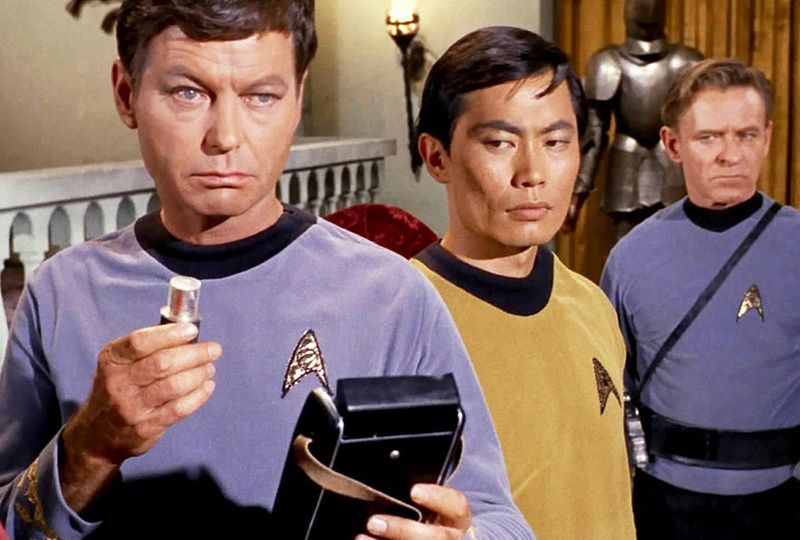
Insight by: Dave Whelan
Over the past few months, I’ve spent a fair amount of time writing about the growing intersection of biology and technology. Over the next few months, I expect that I will continue to spend time writing about the growing intersection of biology and technology.
This month, I am taking things a bit outside the box. In fact, I am taking things outside the atmosphere.
Recently, I surprised my wife with a date night at The Empire Strips Back: A Star Wars Burlesque Parody.* While the show is set in a galaxy far, far away, it is playing here on Earth at Hollywood’s Montalbán Theatre, named in honor of Ricardo Montalbán. While many of us remember Montalbán from his famous TV catchphrases (“Welcome to Fantasy Island!” “rich Corinthian leather”), I was always struck by his eccentric villain role of Khan Noonien Singh in Star Trek II: The Wrath of Khan. From Star Wars to Star Trek, space certainly was on my mind when I left the show.Los Angeles has a long history of innovation and execution in the aerospace industry. The Spruce Goose was built in Culver City, not far from where BioscienceLA is now based. The Space Shuttle was built in Palmdale. El Segundo is now home to the United States Space Force’s Space Systems Command. Companies like Relativity (3D-printed rockets), SpinLaunch (electric-powered kinetic launch systems), and SpaceX (you’ve heard of Elon Musk, right?) have headquarters or major operations in LA. After many years of status quo, the space industry is hot again – and LA is one of the epicenters.
So, what does this have to do with life sciences?
I often show a slide to prospective partners that indicates that biotechnology and other life sciences are very much aligned – directly or indirectly – with the UN’s 17 Sustainable Development Goals. Biotech gives us the power to feed, fuel, and heal the planet. Rather than stopping with that image of Earth, I click one more time to show an image of Mars. Those same biotech innovations will be used to feed, fuel, and heal missions to Mars and beyond.
The flipside is also true, with space innovations informing and inspiring new innovations here on Earth. Those of us of a certain age grew up on products with a space origin – from Tang to Velcro, Fisher Space Pens to “astronaut ice cream” (likely an urban legend with little connection to the freeze-dried reality of space cuisine).
Today, the relationship between space innovation and healthcare innovation is stronger than ever. Experiments on manned space missions and in satellites are being used to accelerate healthcare research. Wearables, advanced diagnostic tests, and remote patient monitoring technologies are being adapted for astronauts and other space travelers. Longevity and hibernation research, along with synthetic biology work to build that feed/fuel/heal infrastructure, continue to accelerate as long-distance space exploration becomes more of a reality. If you think the stakes for healthcare are high on Earth, imagine what they are for a group of space explorers living and working together for years.
Here in Los Angeles, a leader in both life sciences and space innovation, we are seeing numerous examples of these industries converging:
- Earlier this year, Starburst Aerospace, in collaboration with Axiom Space and Boryung, launched the Care in Space Challenge, a first-of-its-kind accelerator program that seeks to foster the development of new innovations for the space healthcare journey, including health monitoring and diagnosis, treatment and therapeutics, and continuing care and life support. As the CIS website notes, participants are “leveraging the extreme conditions of space to not only drive innovation but also to build viable businesses at the intersection of commercial space and biomedical science. It is increasingly evident that space, and in particular microgravity, has profound impacts on the speed of drug discovery, improvements in medical devices, and advancements related to regenerative medicine and life sciences.”
- Spaceomix, a Malta-based start-up, is developing a suite of technologies and services to support genomics research in space. As part of the company’s next stage of growth, it is developing new LA-based operations to capitalize on the expertise in the region.
- Local organizations like the NASA Jet Propulsion Laboratory and Cedars-Sinai Medical Center bring together researchers on a periodic basis to identify ways that innovations in one domain can support the other.
- Mars City Design is bringing together fields like architecture, design, longevity, and agriculture to development sustainable solutions for interplanetary human settlement.
- Unlocking Potential, a digital health conference series on which I partnered this year in Pittsburgh, Birmingham, and Culver City, is expanding its geographic footprint in 2023, as well as expanding its themes to touch on topics of space tourism, physiology research, wearables, and more.
The Cancer Moonshot is once again receiving attention in the world of healthcare research. That’s an area that certainly can benefit from new investment. However, let’s not stop with healthcare on Earth. Let’s continue to think in terms of literal moonshots, where we can help life sciences boldly go where no science has gone before. After all, that might be our best opportunity to live long and prosper.
*I really didn’t know what to expect at The Empire Strips Back, but I was blown away. I could not stop laughing. My wife said she has not laughed that hard in nearly twelve parsecs. (Well, I might be using a bit of poetic license there.) The show is live in Los Angeles right now, and it will be in San Diego soon. I cannot recommend it enough.





